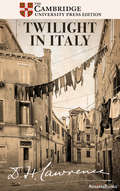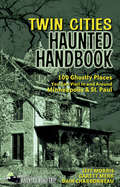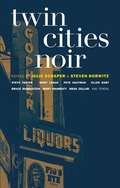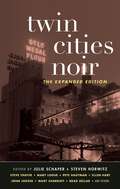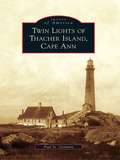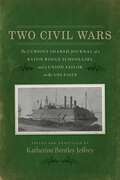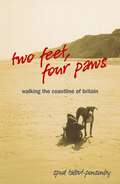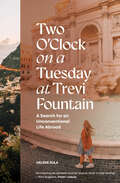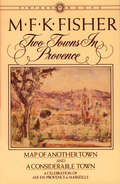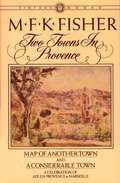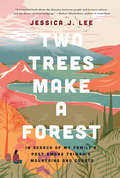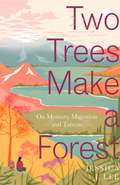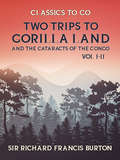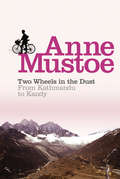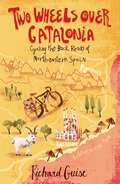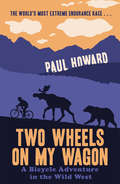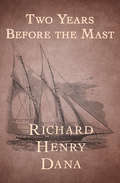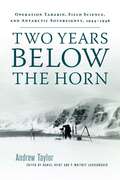- Table View
- List View
Twilight in Italy
by D.H. LawrenceThe author of Sea and Sardinia and Mornings in Mexico shares essays on his travels to Germany, Austria, and Italy. D. H. Lawrence first left England in 1912 and almost immediately began recording his reaction to foreign cultures. Many of those writings became a series of travel articles intended to be published in newspapers; two of them are published here for the first time, deemed too anti-German at the time. Other essays were modified and added to even more observations for Lawrence&’s first travel book, Twilight in Italy, published in 1916. Shaped by the atmosphere of the War, and its rampant anxieties, these essays are imbued with Lawrence&’s intellectual daring and confidence, which raise them above a conventional travel book.
Twin Cities Haunted Handbook
by Garett Merk Jeff Morris Dain CharbonneauTwin Cities Haunted Handbook is the newest book in the Haunted Handbook line within the popular America's Haunted Road Trip series. The Haunted Handbooks are city-specific travel guides to nearly one hundred places within a major city.Twin Cities Haunted Handbook is written with the ghost enthusiast in mind. All 100 chapters contain information on the history as well as the haunting surrounding each location, as well as detailed directions on how to locate each site. Many of the chapters also contain insider information that only a local would know, making it easier for ghost hunters to investigate. Ghost hunters Jeff Morris, Garett Merk, and Dain Charbonneau explore all the best haunted locales Minneapolis has to offer, including Dead Man's Pond, Memorial Pet Cemetery, Padelford Packet Boat Company, the Old Jail Bed and Breakfast, and St. Thomas College and the Legend of the 13 Graves.Each two page entry includes directions from downtown, an historical overview of the haunted place, the story of ghostly doings in that place, and advice on visiting the place yourself-if you dare.
Twin Cities Noir
by Steven Horwitz Julie Schaper"Local editors Schaper and Horwitz have assembled a noteworthy collection of noir-infused stories mixed with laughter...The Akashic noir short-story anthologies are avidly sought and make ideal samplers for regional mystery collecting."--Library Journal"The best pieces in the collection turn the clichés of the genre on their head . . . and despite the unseemly subject matter, the stories are often surprisingly funny."-City Pages (Minneapolis)Brand-new stories from John Jodzio, Tom Kaczynski, and Peter Schilling, Jr., in addition to the original volume's stories by David Housewright, Steve Thayer, Judith Guest, Mary Logue, Bruce Rubenstein, K.J. Erickson, William Kent Krueger, Ellen Hart, Brad Zellar, Mary Sharratt, Pete Hautman, Larry Millett, Quinton Skinner, Gary Bush, and Chris Everheart."St. Paul was originally called Pig's Eye's Landing and was named after Pig's Eye Parrant--trapper, moonshiner, and proprietor of the most popular drinking establishment on the Mississippi. Traders, river rats, missionaries, soldiers, land speculators, fur trappers, and Indian agents congregated in his establishment and made their deals. When Minnesota became a territory in 1849, the town leaders, realizing that a place called Pig's Eye might not inspire civic confidence, changed the name to St. Paul, after the largest church in the city . . . Across the river, Minneapolis has its own sordid story. By the turn of the twentieth century it was considered one of the most crooked cities in the nation. Mayor Albert Alonzo Ames, with the assistance of the chief of police, his brother Fred, ran a city so corrupt that according to Lincoln Steffans its 'deliberateness, invention, and avarice has never been equaled.' As recently as the mid-'90s, Minneapolis was called 'Murderopolis' due to a rash of killings that occurred over a long hot summer . . . Every city has its share of crime, but what makes the Twin Cities unique may be that we have more than our share of good writers to chronicle it. They are homegrown and they know the territory--how the cities look from the inside, out . . ."
Twin Cities Noir: The Expanded Edition (Akashic Noir #0)
by Larry Millett Ellen Hart Steve Thayer K. J. Erickson Judith Guest Mary Logue Pete Hautman Mary Sharratt William Kent Krueger David Housewright Quinton Skinner Tom Kaczynski John Jodzio Bruce Rubenstein Peter Schilling Jr. Brad Zellar Gary Bush Chris Everheart"Local editors Schaper and Horwitz have assembled a noteworthy collection of noir-infused stories mixed with laughter...The Akashic noir short-story anthologies are avidly sought and make ideal samplers for regional mystery collecting."--Library Journal"The best pieces in the collection turn the clichés of the genre on their head . . . and despite the unseemly subject matter, the stories are often surprisingly funny."-City Pages (Minneapolis)Brand-new stories from John Jodzio, Tom Kaczynski, and Peter Schilling, Jr., in addition to the original volume's stories by David Housewright, Steve Thayer, Judith Guest, Mary Logue, Bruce Rubenstein, K.J. Erickson, William Kent Krueger, Ellen Hart, Brad Zellar, Mary Sharratt, Pete Hautman, Larry Millett, Quinton Skinner, Gary Bush, and Chris Everheart."St. Paul was originally called Pig's Eye's Landing and was named after Pig's Eye Parrant--trapper, moonshiner, and proprietor of the most popular drinking establishment on the Mississippi. Traders, river rats, missionaries, soldiers, land speculators, fur trappers, and Indian agents congregated in his establishment and made their deals. When Minnesota became a territory in 1849, the town leaders, realizing that a place called Pig's Eye might not inspire civic confidence, changed the name to St. Paul, after the largest church in the city . . . Across the river, Minneapolis has its own sordid story. By the turn of the twentieth century it was considered one of the most crooked cities in the nation. Mayor Albert Alonzo Ames, with the assistance of the chief of police, his brother Fred, ran a city so corrupt that according to Lincoln Steffans its 'deliberateness, invention, and avarice has never been equaled.' As recently as the mid-'90s, Minneapolis was called 'Murderopolis' due to a rash of killings that occurred over a long hot summer . . . Every city has its share of crime, but what makes the Twin Cities unique may be that we have more than our share of good writers to chronicle it. They are homegrown and they know the territory--how the cities look from the inside, out . . ."
Twin Lights of Thacher Island, Cape Ann
by Paul St. GermainThacher Island was named for Anthony Thacher who, in 1635, lost his four children and other family members in a shipwreck during the most severe storm to ever hit the Massachusetts coast. Only Anthony and his wife Elizabeth survived. The lighthouses have played an important role in several wars, including the Revolutionary War and World Wars I and II, when the navy established a radio compass station to protect the coast from enemy submarines. A ship bearing a U.S. president almost wrecked on Thacher Island, and the island was used as a witness protection site for a Mafia criminal. Twin Lights of Thacher Island, Cape Ann captures the history, adventures, and intimate stories from over 200 years of lighthouse keepers living on the island, including how the two towers were built and how scientific discoveries were applied to improve the lights over the years.
Twittando su un risciò.
by Stefan Mey Manuela GalloIl nuovo ceto medio indiano abbraccia la tecnologia e i social media. In tale contesto un giornalista tenta di fare business, ma in realtà deve fare i conti con varie sfide interculturali. Ho scritto il mio libro “India 2.0- Twittando su un risciò” nel corso del mio viaggio di cinque mesi in India. Tratta di tecnologia, del nascente ceto medio, di incontri con una cultura diversa e di religione. La storia: sono giunto in India per lavorare come giornalista, ma sul mio cammino ho incontrato difficoltà di diversa natura, dovute alle differenze con la cultura locale o ai miei problemi di salute. Queste mi hanno spinto a rinunciare al mio incarico ma non al mio viaggio e ho continuato così ad attraversare l’India in lungo e largo. Ho partecipato a convegni e visitato Ashram, dialogato con hippie a Goa e con esperti di induismo. L’intero libro è intriso di autoironia e humour, ma dà anche consigli a chi ha intenzione di lavorare come freelance in questa economia in crescita. "Twittando su un risciò" si consiglia ai cosiddetti ‘nomadi digitali’ e ai lavoratori freelance.
Two Civil Wars: The Curious Shared Journal of a Baton Rouge Schoolgirl and a Union Sailor on the USS Essex
by Katherine Bentley JeffreyTwo Civil Wars is both an edition of an unusual Civil War--era double journal and a narrative about the two writers who composed its contents. The initial journal entries were written by thirteen-year-old Celeste Repp while a student at St. Mary's Academy, a prominent but short-lived girls school in midcentury Baton Rouge. Celeste's French compositions, dating from 1859 to 1861, offer brief but poignant meditations, describe seasonal celebrations, and mention by name both her headmistress, Matilda Victor, and French instructor and priest, Father Darius Hubert. Immediately following Celeste's prettily decorated pages a new title page intervenes, introducing "An Abstract Journal Kept by William L. Park, of the U. S. gunboat Essex during the American Rebellion. " Park's diary is a fulsome three-year account of military engagements along the Mississippi and its tributaries, the bombardment of southern towns, the looting of plantations, skirmishes with Confederate guerillas, the uneasy experiment with "contrabands" (freed slaves) serving aboard ship, and the mundane circumstances of shipboard life. Very few diaries from the inland navy have survived, and this is the first journal from the ironclad Essex to be published. Jeffrey has read it alongside several unpublished accounts by Park's crewmates as well as a later memoir composed by Park in his declining years. It provides rare insight into the culture of the ironclad fleet and equally rare firsthand commentary by an ordinary sailor on events such as the sinking of CSS Arkansas and the prolonged siege of Port Hudson. Jeffrey provides detailed annotation and context for the Repp and Park journals, filling out the biographies of both writers before and after the Civil War. In Celeste's case, Jeffrey uncovers surprising connections to such prominent Baton Rouge residents as the diarist Sarah Morgan, and explores the complexity of wartime allegiances in the South through the experiences of Matilda Victor and Darius Hubert. She also unravels the mystery of how a southern youngster's school scribbler found its way into the hands of a Union sailor. In so doing, she provides a richly detailed picture of occupied Baton Rouge and especially of events surrounding the Battle of Baton Rouge in August 1862. These two unusual personal journals, linked by curious happenstance in a single notebook, open up intriguing, provocative, and surprisingly complementary new vistas on antebellum Baton Rouge and the Civil War on the Mississippi.
Two Feet, Four Paws: Walking the Coastline of Britain
by Spud Talbot-PonsonbyTake one headstrong dog and a feisty young woman, and send them off on a walk for the equivalent distance of London to Delhi. Two Feet, Four Paws is the heart-warming tale of one dog and her woman, who face the daily physical and mental challenges with a sense of humour and more determination with each mile.
Two Feet, Four Paws: Walking the Coastline of Britain
by Spud Talbot-PonsonbyTake one headstrong dog and a feisty young woman, and send them off on a walk for the equivalent distance of London to Delhi. Two Feet, Four Paws is the heart-warming tale of one dog and her woman, who face the daily physical and mental challenges with a sense of humour and more determination with each mile.
Two For The Road (Mary-Kate and Ashle, Two of a Kind Series)
by Nancy Butcher Mary-Kate Olsen Ashley OlsenDear Diary, So far this school trip to sunny Florida has been a blast. I've even been made captain of our triathalon sports team! But now Dana Woletsky has shown up and she wants to take the team away from me. She wants to take my boyfriend, Ross, away, too! How can I keep her from ruining my summer? I wish Mary-Kate could help, but she can't. She's spending all her time frantically looking for her lost diary. She says there's something in it no one should read, but she won't tell me what it is. I mean, what could be so bad? -- Ashley
Two Kitchens: 120 Family Recipes from Sicily and Rome
by Rachel RoddyFrom the award-winning weekly Guardian Cook columnist and winner of the André Simon and Guild of Food Writers' Awards comes an Italian food book of sumptuous recipes, flavours and stories from Sicily and Rome.For the last twelve years, food-writer, cook and photographer Rachel Roddy has immersed herself in the culture of Roman cooking, but it was the flavours of the south that she and her Sicilian partner, Vincenzo, often craved. Eventually the chance arose to spend more time at his old family house in south-east Sicily, where Rachel embraced the country's traditional recipes and the stories behind them. In Two Kitchens Rachel celebrates the food and flavours of Rome and Sicily and shares over 120 of these simple, everyday dishes from her two distant but connected kitchens. From tomato and salted ricotta salad, caponata and baked Sicilian pasta to lemon crumble, honeyed peaches and almond and chocolate cake, they are the authentic Italian recipes that you will want to cook again and again until you've made them your own.'This is a recipe book that reflects the way I cook and eat: uncomplicated, direct and adaptable Italian family food that reflects the season. The two kitchens of the title are my kitchens in Rome and Sicily. In a sense, though, we could have called the book "many kitchens" as I invite you to make these recipes your own.' Rachel RoddyTwo Kitchens chapters: Vegetables and Herbs - Tomatoes; Aubergines; Peas; Broad Beans; Cauliflower; Potatoes; Onions; HerbsFruit and Nuts - Lemons; Peaches; Oranges; Grapes and Figs; AlmondsMeat, Fish and Dairy - Beef and pork; Chicken; White fish; Fresh anchovies and sardines; Eggs; RicottaStorecupboard - Chickpeas; Lentils; Preserved anchovies; Flour; BreadRachel's first book, Five Quarters: Recipes and Notes from a Kitchen in Rome, won the André Simon Food Book Award and the Guild of Food Writers' First Book Award in 2015.
Two O'Clock on a Tuesday at Trevi Fountain: A Search for an Unconventional Life Abroad
by Helene Sula"An inspiring yet relatable read for anyone ready to stop settling." —Nina Ruggiero, Travel + Leisure In this inspiring travel memoir—the antidote to the &“just quit your job and ditch all your belongings to backpack the world&” mentality—a young woman explores how she took calculated risks to follow her dreams: traveling and living abroad without sacrificing stability and comfort.Like many young professionals, Helene settled into a steady 9-5, watching the clock tick by and dreaming of seeing the world one day. But after a climbing accident leaves her bedbound for months, she finds a new voice connecting with others online and starts a blog to write about her true passion: travel. When her blog takes off and a sponsored trip overseas opens her eyes, she wonders: could she lead a stable life while traveling the world?From skinny dipping in the icy Baltic and hiking Germany&’s storied Black Forest, to wrestling with visa applications and apartment hunting in medieval Heidelberg, Helene shares the realities—both the magical and the mundane—that come with chasing bold dreams and learning that home is where you make it. For those who fear change, the secret lies in taking calculated risks.Uplifting yet candid, this travel memoir will inspire others to take chances and transform their own lives. But you don&’t have to uproot your life to find meaning—just have the heart to take a leap.
Two Towns in Provence
by M. F. K. FisherThis memoir of the French provincial capital of Aix-en-Provence is, as the author tells us, "my picture, my map, of a place and therefore of myself...just as much of its reality is based on my own shadows, my inventions." A vibrant and perceptive profile of the kinship between a person and a place. M.F.K. Fisher scans the centuries to reveal the ancient sources that clarify the Marseille of today and the indestructible nature of its people A delightful journey filtered through the senses of a profound writer.
Two Towns in Provence: A Map of Another Town, and a Considerable Town
by M. F. K. FisherThis memoir of the French provincial capital of Aix-en-Provence is, as the author tells us, "my picture, my map, of a place and therefore of myself... just as much of its reality is based on my own shadows, my inventions." A vibrant and perceptive profile of the kinship between a person and a place. In A Considerable Town, M.F.K. Fisher scans the centuries to reveal the ancient sources that clarify the Marseille of today and the indestructible nature of its people. A delightful journey filtered through the senses of a profound writer.
Two Trees Make a Forest: In Search of My Family's Past Among Taiwan's Mountains and Coasts
by Jessica J. LeeThis "stunning journey through a country that is home to exhilarating natural wonders, and a scarring colonial past . . . makes breathtakingly clear the connection between nature and humanity, and offers a singular portrait of the complexities inherent to our ideas of identity, family, and love" (Refinery29).A chance discovery of letters written by her immigrant grandfather leads Jessica J. Lee to her ancestral homeland, Taiwan. There, she seeks his story while growing closer to the land he knew.Lee hikes mountains home to Formosan flamecrests, birds found nowhere else on earth, and swims in a lake of drowned cedars. She bikes flatlands where spoonbills alight by fish farms, and learns about a tree whose fruit can float in the ocean for years, awaiting landfall. Throughout, Lee unearths surprising parallels between the natural and human stories that have shaped her family and their beloved island. Joyously attentive to the natural world, Lee also turns a critical gaze upon colonialist explorers who mapped the land and named plants, relying on and often effacing the labor and knowledge of local communities.Two Trees Make a Forest is a genre–shattering book encompassing history, travel, nature, and memoir, an extraordinary narrative showing how geographical forces are interlaced with our family stories.
Two Trees Make a Forest: On Memory, Migration and Taiwan
by Jessica J. LeeI have learned many words for 'island': isle, atoll, eyot, islet, or skerry. They exist in archipelagos or alone, and always, by definition, I have understood them by their relation to water. But the Chinese word for island knows nothing of water. For a civilisation grown inland from the sea, the vastness of mountains was a better analogue: (dao, 'island') built from the relationship between earth and sky.Between tectonic plates and conflicting cultures, Taiwan is an island of extremes: high mountains, exposed flatlands, thick forests. After unearthing a hidden memoir of her grandfather's life, written on the cusp of his total memory loss, Jessica J Lee hunts his story, in parallel with exploring Taiwan, hoping to understand the quakes that brought her family from China, to Taiwan and Canada, and the ways in which our human stories are interlaced with geographical forces. Part-nature writing, part-biography, Two Trees Make a Forest traces the natural and human stories that shaped an island and a family.
Two Trips to Gorilla Land and the Cataracts of the Congo Vol I & Vol II (Classics To Go)
by Richard Francis Burton(Excerpt): "The notes which form the ground-work of these volumes have long been kept in the obscurity of manuscript: my studies of South America, of Syria and Palestine, of Iceland, and of Istria, left me scant time for the labour of preparation. Leisure and opportunity have now offered themselves, and I avail myself of them in the hope that the publication will be found useful to more than one class of readers. The many who take an interest in the life of barbarous peoples may not be displeased to hear more about the Fán; and the few who would try a fall with Mister Gorilla can learn from me how to equip themselves, whence to set out and whither to go for the best chance. Travelling with M. Paul B. du Chaillu's "First Expedition" in my hand, I jealously looked into every statement, and his numerous friends will be pleased to see how many of his assertions are confirmed by my experience."
Two Wheels In The Dust: From Kathmandu to Kandy
by Anne MustoeIndia is no place for the faint-hearted cyclist. The streets are jammed with cars, busses, rickshaws, animals, fortune-tellers, barbers, beggars and people sleeping or cooking. Following the success of her two previous outings, A Bike Ride and Lone Traveller, adventuresome ex-headmistress Anne Mustoe donned the cycle helmet once more and set out on an exhilarating journey round the Indian subcontinent. Beginning in Kathmandu in Nepal and ending in the tranquil hill town of Kandy in Sri Lanka, Anne's amazing journey is told with keen observation and the relish of the open road.
Two Wheels Over Catalonia: Cycling the Back Roads of North-Eastern Spain
by Richard GuiseSixteen years after moving to Catalonia, Richard finally finds time to slow down and explore the back roads by bicycle. Dipping into the unique history of this fiercely independent nation-within-a-nation, and chancing upon nudist beaches, ancient Iberian sites and revolutionary road-sweepers, this slow cyclist revels in authentic Catalonia.
Two Wheels Over Catalonia: Cycling the Back Roads of North-Eastern Spain
by Richard GuiseSixteen years after moving to Catalonia, Richard finally finds time to slow down and explore the back roads by bicycle. Dipping into the unique history of this fiercely independent nation-within-a-nation, and chancing upon nudist beaches, ancient Iberian sites and revolutionary road-sweepers, this slow cyclist revels in authentic Catalonia.
Two Wheels on my Wagon: A Bicycle Adventure in the Wild West
by Paul HowardAs bicycle races go, the attractions of the Tour Divide are not immediately apparent. For a start, it is the longest mountain-bike race in the world, running nearly 3,000 miles down the Rockies from Canada to Mexico. But the distance is not the only challenge - the total ascent of 200,000 ft is the equivalent of scaling Mount Everest nearly seven times.Then there are the dangerous animals likely to be encountered on the route: grizzly bears, mountain lions and wolves, not to mention rattlesnakes and tarantulas. Worse, the rewards for all this effort are strictly limited. Unlike in the Tour de France, there is no fabled yellow jersey and no prize money.Yet, undaunted, and in spite of never having owned a mountain bike, Paul Howard signed up. Battling the worst weather for generations, drinking whiskey with a cowboy and singing karaoke with the locals, Howard's journey turned into more than just a race - it became the adventure of a lifetime.
Two Years Before the Mast: A Personal Narrative Of Life At Sea
by Richard DanaThis legendary account of a voyage around Cape Horn captures the majesty and misadventure of life at sea in the early nineteenth century In 1834, nineteen-year-old Richard Henry Dana left Harvard University to enlist as a deckhand on a brig sailing from Boston to the California coast. For the next two years, he recorded the terrifying storms, awe-inspiring beauty, and dreadful hardships of the journey in a diary he would later expand into this riveting memoir of "the life of a common sailor at sea as it really is." Dana spares no detail in portraying the wretched conditions he endured and the cruelty of the ship's captain, but he also paints vivid, unforgettable pictures of natural wonders such as icebergs and schools of migrating whales. His descriptions of the missions and presidios of pre-Gold Rush California captured the imagination of the country when the book was first published in 1840, and they serve as valuable historical documentation to this day. An instant classic and inspiration for contemporaries such as Herman Melville, Two Years Before the Mast is one of the most remarkable and influential adventure stories in American literature. This ebook has been professionally proofread to ensure accuracy and readability on all devices.
Two Years Below the Horn: Operation Tabarin, Field Science, and Antarctic Sovereignty, 1944-1946
by Andrew Taylor Daniel Heidt Whitney LackenbauerIn "Two Years Below the Horn," engineer Andrew Taylor vividly recounts his experiences and accomplishments during Operation Tabarin, a landmark British expedition to Antarctica to establish sovereignty and conduct science during the Second World War. When mental strain led the operation’s first commander to resign, Taylor—a military engineer with extensive prewar surveying experience—became the first and only Canadian to lead an Antarctic expedition. As commander of the operation, Taylor oversaw construction of the first permanent base on the Antarctic continent at Hope Bay. From there, he led four-man teams on two epic sledging journeys around James Ross Island,overcoming arduous conditions and correcting cartographic mistakes made by previous explorers. The editors’ detailed afterword draws on Taylor’s extensive personal papers to highlight Taylor’s achievements and document his significant contributions to polar science. This book will appeal to readers interested in the history of polar exploration, science, and sovereignty. It also sheds light on the little known contribution of a Canadian to a distant theatre of the Second World War. The wartime service of Major Taylor reveals important new details about a groundbreaking operation that laid the foundation for the British Antarctic Survey and marked a critical moment in the transition from the heroic to the modern scientific era in polar exploration.
